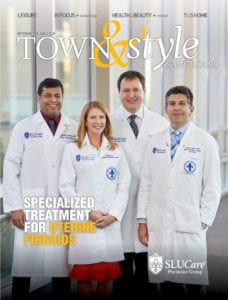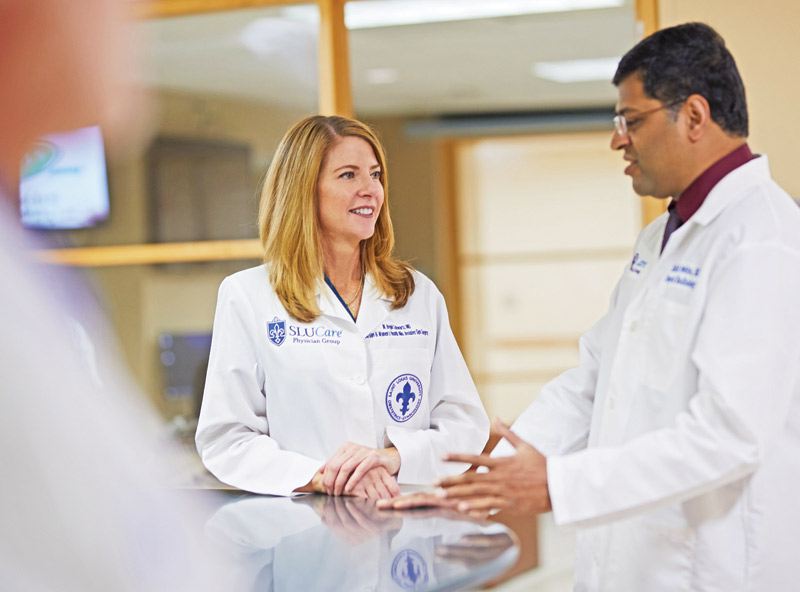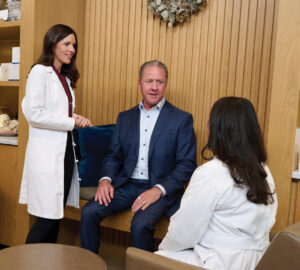If you’re a woman with uterine fibroids, there’s a good chance you have grappled with abdominal pain and pressure, abnormal bleeding, digestive issues, discomfort during sex or other related problems. Fibroids are benign growths of varying size inside or attached to the uterine wall, and symptoms can differ. It’s not clear what causes them, but they are a common problem, and SLUCare physicians offer important solutions for women who struggle with the condition.
 SLUCare understands that each woman’s body, needs and preferences are different, so it provides a number of options for fighting fibroids, says gynecologist Dr. Brigid Holloran-Schwartz. Depending on the patient’s needs, treatment plans may include medication, removal of individual growths, uterine fibroid embolization (UFE), endometrial ablation or hysterectomy. Treatment is based on factors like the size and number of growths, where they are located, symptoms, the patient’s age and health, and whether she plans to become pregnant.
SLUCare understands that each woman’s body, needs and preferences are different, so it provides a number of options for fighting fibroids, says gynecologist Dr. Brigid Holloran-Schwartz. Depending on the patient’s needs, treatment plans may include medication, removal of individual growths, uterine fibroid embolization (UFE), endometrial ablation or hysterectomy. Treatment is based on factors like the size and number of growths, where they are located, symptoms, the patient’s age and health, and whether she plans to become pregnant.
“Fibroids can be the size of a pea and cause heavy bleeding, or they can be larger and not cause symptoms,” Holloran-Schwartz says. “Each patient’s situation is unique, so we create personalized treatment plans. Many women believe that heavy blood flow is just a part of life because their mothers or grandmothers had it, and they go through many tampons or pads each day or wake up to heavy bleeding. We want them to know there are solutions to these problems. They shouldn’t be afraid to wear white.”
Holloran-Schwartz says women come to SLUCare because their lives have been interrupted by troubling fibroid symptoms. Patients are encouraged to consult with a physician and find out which treatment options are best for them. Some women benefit from UFE, a minimally invasive procedure that involves passing a tiny catheter through an incision in the wrist. Then, small particles are injected to block vessels that feed the fibroids so they shrink from lack of blood supply. This way, the uterus is preserved and continues to function normally, says SLUCare interventional radiologist Dr. Keith Pereira, whose department often partners with SLUCare gynecologists to provide fibroid treatment. UFE is an important option because many women aren’t done having children or don’t want a hysterectomy, he notes. “There is no hospital stay, any pain is well controlled, and patients can return to regular activity shortly afterward,” he says. “In four to six weeks, they normally see a significant decrease in their symptoms.”
SLUCare physicians are in tune with patients’ busy lifestyles and design treatment plans that allow them to return to job and family obligations as soon as possible. For example, a patient might have UFE done on a Thursday, rest over the weekend and return to most normal activities by Monday, Pereira says.
According to Holloran-Schwartz, SLUCare offers a team approach to care and a high level of patient satisfaction for women with fibroids. “We collaborate with our colleagues and counsel patients carefully because we want each woman to be happy and well,” she says.
SLUCare Physician Group offers a comprehensive program of care for women with uterine fibroids. Pictured on the cover: Dr. Keith Pereira, Dr. Brigid Holloran-Schwartz, Dr. E. Cristian Campian, Dr. Pericles Xynos. For more information, call 314.768.8730 or visit slucare.edu/fibroids.
Cover design by Julie Streiler
Cover photo courtesy of SLUCare Physician Group
Pictured above: Dr. Brigid Holloran-Schwartz consults with Dr. Keith Pereira.








